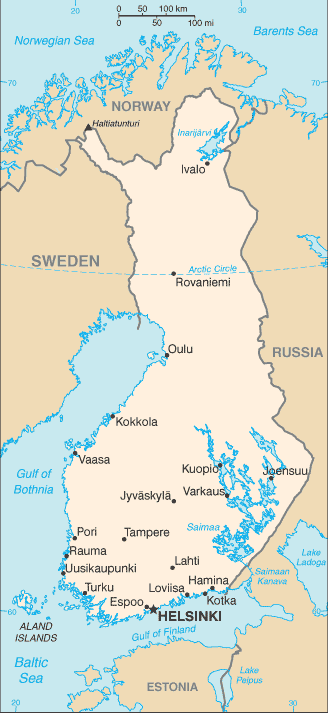|
Finland
|

|
Capital: Helsinki
Population: 5,532,156
Brief History of Finland:
The Finnish people settled in the land that is today call Finland thousands of years ago. During the 12th Century, the Kingdom of Swedentook over the land and it remained a part of Sweden for almost 700 years. During this time, Swedish took over as the dominant language in the area. The language eventually reverted back to Finnish during the 1800s.
In 1809, Russia and the armies of Czar Alexander I conquered Finland and took possession of the land. It became a grand duchy of Russia for around 100 years.
In 1835, the publication of the Finnish national epic, The Kalevala--a collection of traditional myths and legends--first stirred the nationalism that later led to Finland's independence from Russia. When the Bolshevik Revolution occurred in Russia in 1917 Finland claimed independence. Finland staunchly defended its independence including fighting wars against the Soviet Union during World War II. During the Cold War, Finland was considered a neutral country and a grey zone between the West and the Soviet Union.
The Geography of Finland
Total Size: 338,145 square km
Size Comparison: slightly smaller than Montana
Geographical Coordinates: 64 00 N, 26 00 E
World Region or Continent: Europe
General Terrain: mostly low, flat to rolling plains interspersed with lakes and low hills
Geographical Low Point: Baltic Sea 0 m
Geographical High Point: Haltiatunturi 1,328 m
Climate: cold temperate; potentially subarctic but comparatively mild because of moderating influence of the North Atlantic Current, Baltic Sea, and more than 60,000 lakes
Major cities: HELSINKI (capital) 1.107 million (2009), Espoo, Tampere, Vantaa
The People of Finland
Type of Government: republic
Languages Spoken: Finnish 92% (official), Swedish 5.6% (official), other 2.4% (small Sami- and Russian-speaking minorities) (2003)
Independence: 6 December 1917 (from Russia)
National Holiday: Independence Day, 6 December (1917)
Nationality: Finn(s)
Religions: Lutheran National Church 84.2%, Greek Orthodox in Finland 1.1%, other Christian 1.1%, other 0.1%, none 13.5% (2003)
National Symbol: lion
National Anthem or Song: Maamme (Our Land)
Economy of Finland
Major Industries: metals and metal products, electronics, machinery and scientific instruments, shipbuilding, pulp and paper, foodstuffs, chemicals, textiles, clothing
Agricultural Products: barley, wheat, sugar beets, potatoes; dairy cattle; fish
Natural Resources: timber, iron ore, copper, lead, zinc, chromite, nickel, gold, silver, limestone
Major Exports: machinery and equipment, chemicals, metals; timber, paper, pulp (1999)
Major Imports: foodstuffs, petroleum and petroleum products, chemicals, transport equipment, iron and steel, machinery, textile yarn and fabrics, grains
Currency: euro (EUR)
National GDP: $194,300,000,000
** Source for population (2012 est.) and GDP (2011 est.) is CIA World Factbook.
Back to Geography Home Page
